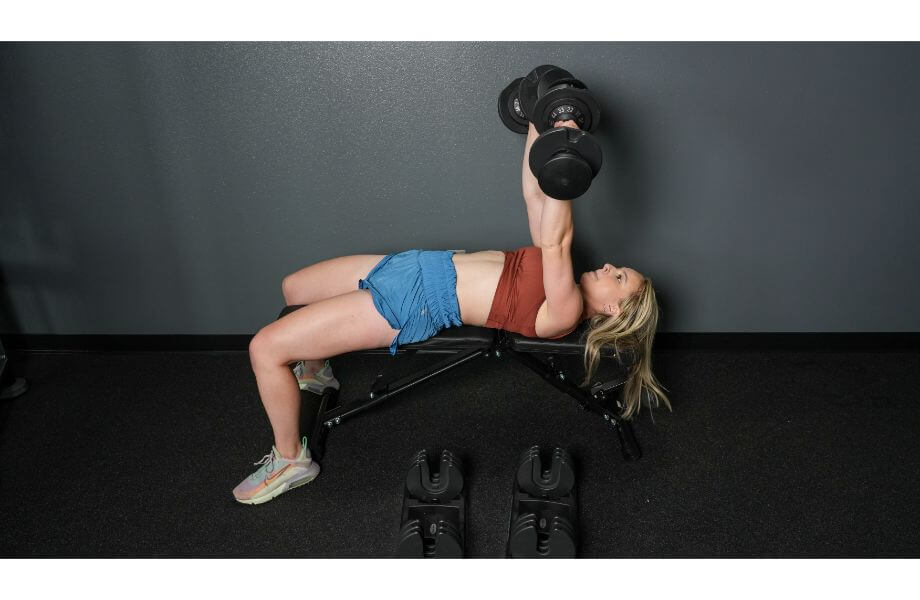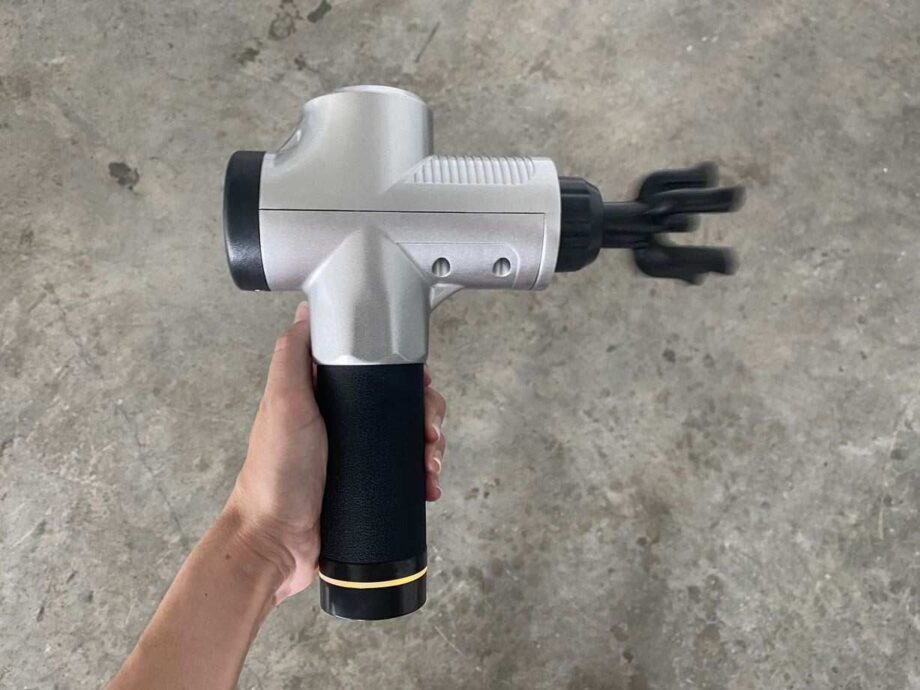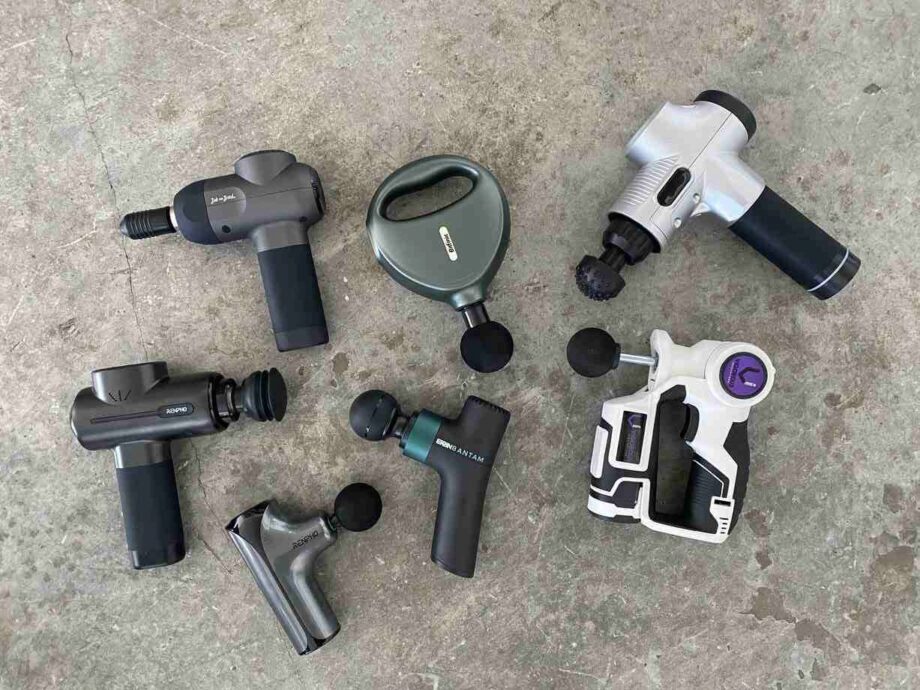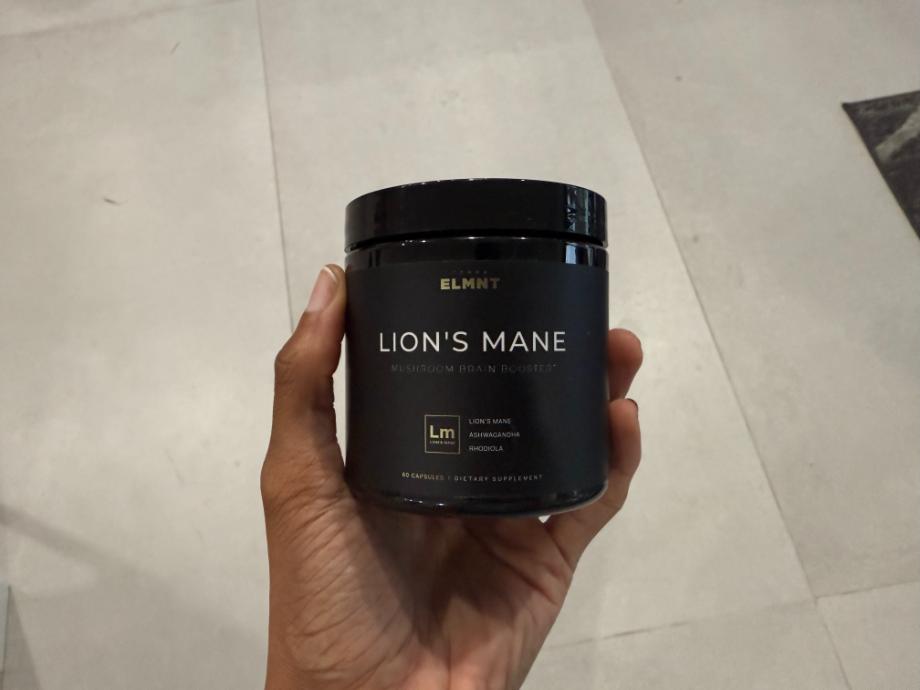Often, the reason people start any strength training program is for weight loss because wanting to like what you see (in the mirror) is a powerful motivator for change. When you walk into a gym, there are lots of tools to pick from, so which one do you choose?
In this certified personal trainer’s opinion, dumbbell workouts for weight loss are the best option for beginner through intermediate trainees because of a few factors. With dumbbells, even when lifting two, each side works unilaterally to help improve strength imbalances between sides. Doing this means your body is working harder, and this means more calorie burn.
More stabilizing muscles are involved in holding and lifting the dumbbells because their range of motion and lifting path is NOT fixed like a machine or barbell. What does this mean for you? You work more muscles with less weight for a better calorie burn.
Now you know why dumbbells are great for weight loss, let’s get into specifics below.
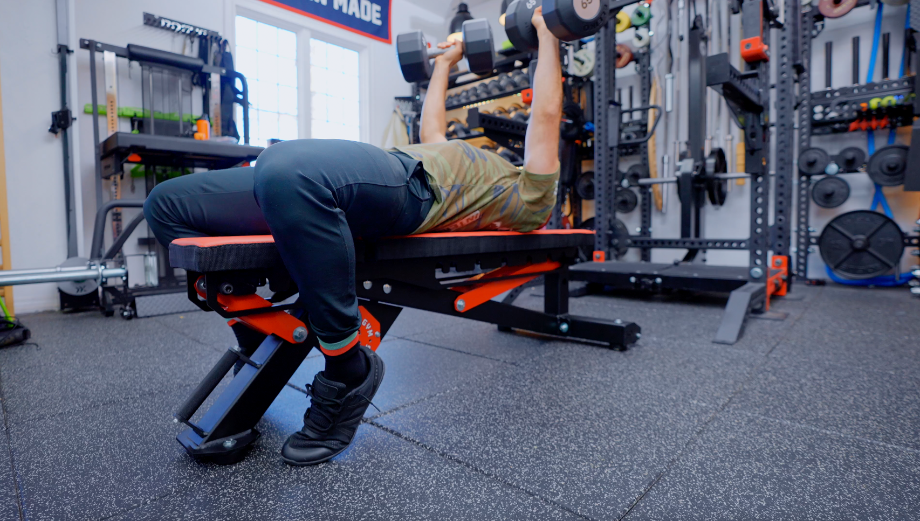
The Best Dumbbell Workouts for Weight Loss
Below are the 15 exercises that will make up the workouts. When choosing dumbbell exercises for weight loss, you want exercises that hit multiple muscle groups (compound exercises) for better potential calorie burn for increased weight loss.
But we’re not discounting isolation exercises (one muscle group only) because they will act like filler exercises (rest and recovery exercises) between the compound moves and give you a muscle pump.
The following exercises cover lower-body and upper-body muscle groups and will form the basis of the workouts.
- Dumbbell goblet squat
- Dumbbell bench press
- Dumbbell Romanian deadlift
- Reverse lunges
- Biceps curls
- Bent-over row
- Shoulder press
- Lateral raises
- Turkish get-up
- Dumbbell reverse flys
- Dumbell split squat
- Dumbell hip thrust
- Dumbbell squat to press
- Dumbbell 3-point row
- Dumbbell pullover
Full-Body Dumbbell Workout for Weight Loss
Now for the “fun” part: the workout. Below is a high-intensity workout you can plug into your routine when you want to burn fat, lose fat and look better in the mirror. This workout isn’t written in stone, and other exercises above can be substituted to prevent boredom and overuse injuries.
For instructions on how to do these movements, scroll to the step-by-step-guides below.
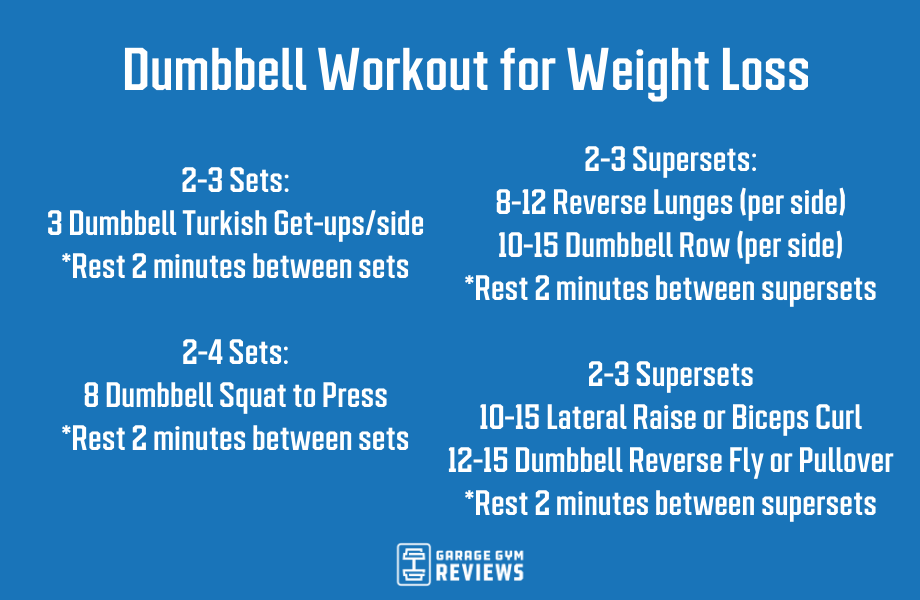
2-3 Sets:
3 Dumbbell Turkish Get-ups/side
*Rest 2 minutes between sets
2-4 Sets:
8 Dumbbell Squat to Press
*Rest 2 minutes between sets
2-3 Supersets:
8-12 Reverse Lunges or Split Squats (per side)
10-15 Dumbbell Row (per side)
*Rest 2 minutes between supersets
2-3 Supersets
10-15 Lateral Raise or Biceps Curl
12-15 Dumbbell Reverse Fly or Pullover
*Rest 2 minutes between supersets
Dumbbell Goblet Squat
Muscles worked: Quads, glutes, hamstrings, anterior core, and upper back
Why you should do it: Holding the dumbbell anteriorly allows you to get into a squat easily and brings the core and upper back into it to work more muscle.
How to do it:
- Grip underneath one end of the dumbbell underneath your chin at chest height.
- Get your shoulders down, chest up, and feet shoulder-width or in your preferred squat position.
- Squat to your depth, sending the hips slightly back and down.
- Push your feet through the floor and squat until you lock your knees and glutes.
- Reset and repeat.
Sets, reps, and rest time: Perform three to four sets of between eight to 15 reps, resting one to two minutes between sets.
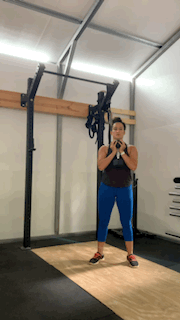
Dumbbell Bench Press
Muscles worked: Triceps, pectorals, and anterior deltoids
Why you should do it: Works the chest and triceps in a shoulder-friendly fashion to increase the size and strength, strengthens imbalances between sides, and improves your push-up.
How to do it:
- Sit a pair of dumbbells on your knees while sitting on a weight bench
- Lie back while pressing the dumbbells above your chest.
- Lower the dumbbells while keeping your upper-arm angle at around 45 degrees.
- Once your elbows are level with your torso, push the dumbbells using your chest and triceps.
- Reset and repeat
Sets, reps, and rest time: Perform two to three sets of between six to 12 reps with one to two minutes of rest between sets.
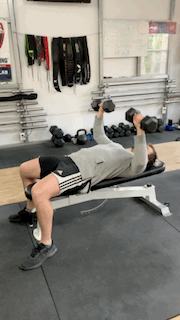
Dumbbell Romanian Deadlift
Muscles worked: Forearms, upper back, lower back, glutes, and hamstrings
Why you should do it: The dumbbell RDL works the posterior muscles as a unit to improve the look of your glutes and hamstrings.
How to do it:
- Hold a pair of dumbbells in front of your quads at arm’s length.
- With your chest up and shoulders down, push your hips back while keeping a slight bend in your knees.
- Keep going until the dumbbells are below your knees and you feel the tension in your hamstrings.
- Stand back up using your glutes and hamstrings until you return to the starting position.
Sets, reps, and rest time: Perform two to four sets of between six to twelve reps, resting 90 to 120 seconds.
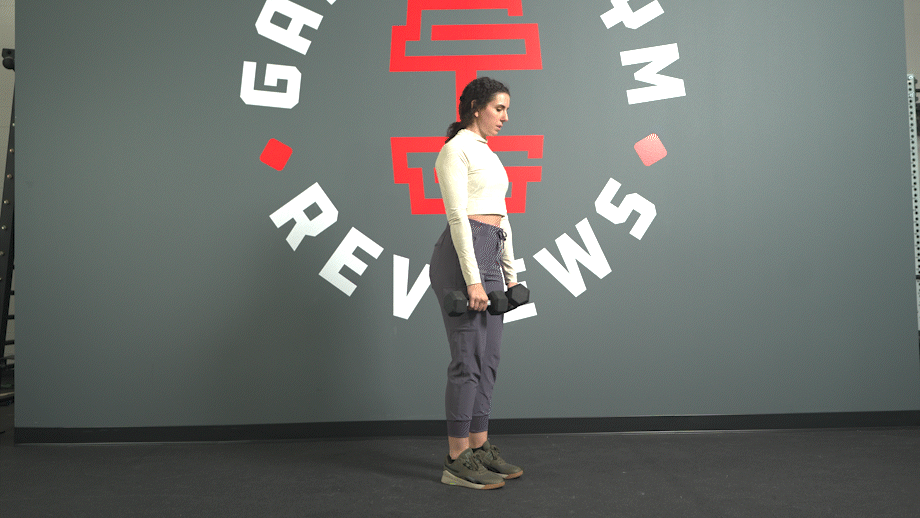
Reverse Lunge
Muscles worked: Quads, glutes, calves, and hamstrings
Why you should do it: Strengthens the muscles unilaterally to correct imbalances between sides for improved muscular development. Plus, it is easier on the knee if knee pain is an issue.
How to do it:
- Hold a pair of dumbbells in your preferred position and feet hip-width apart.
- With your shoulders down and chest up, step back with the right foot and lower your right knee to the floor.
- Your left thigh should be parallel to the ground with a slight forward lean of your upper body.
- Push your left foot through the floor and return your feet to the starting position.
- Do all your reps on one side or alternate sides—your choice.
Sets, reps, and rest time: Perform two to four sets of eight to 15 reps on each side, resting one to two minutes between sets.
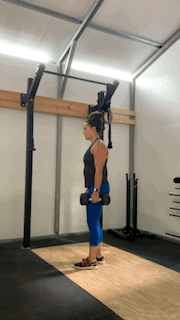
Biceps Curl
Muscles worked: Forearms, biceps, and anterior deltoid
Why you should do it: Do you really need me to give you a reason? Curls, among the vanity benefits, will improve your grip strength, too.
How to do it:
- Hold a pair of dumbbells at arm’s length with a neutral, overhand, or underhand grip while standing up straight.
- With your upper back and glutes engaged, curl the dumbbells to your shoulders until your elbows are fully flexed.
- Slowly lower down until your elbows are extended and reset and repeat.
Sets, reps, and rest time: Perform two to three sets of eight to 20 reps, resting 60 to 90 seconds between sets.
RELATED: How to Do a Hammer Curl
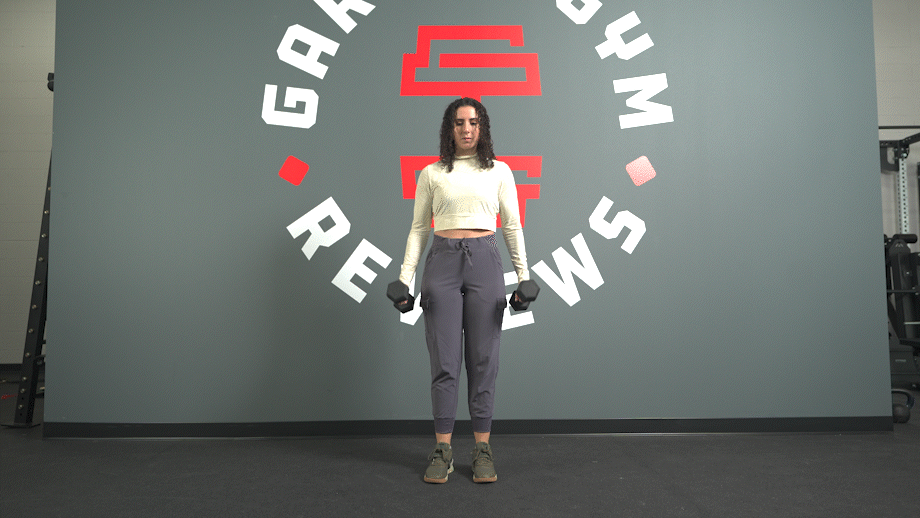
Bent-Over Row
Muscles worked: Forearms, biceps, rhomboids, traps, lats, lower back, glutes, and hamstrings
Why you should do it: All rows train the muscles essential for posture, but the bent-over row trains the glutes, lower back, and hamstrings for more total body muscle and increased calorie burn.
How to do it:
- Hold a pair of dumbbells by your sides in a neutral grip with your shoulders down and chest up.
- Perform an RDL (described above) until the dumbbells are below your knees.
- Keep your shoulders down, chest up, and neutral spine; row the dumbbells to the outside of your hips.
- Slowly lower until your elbows are straight and reset and repeat.
Sets, reps, and rest time: Perform three sets of eight to 15 reps, resting two minutes between sets.
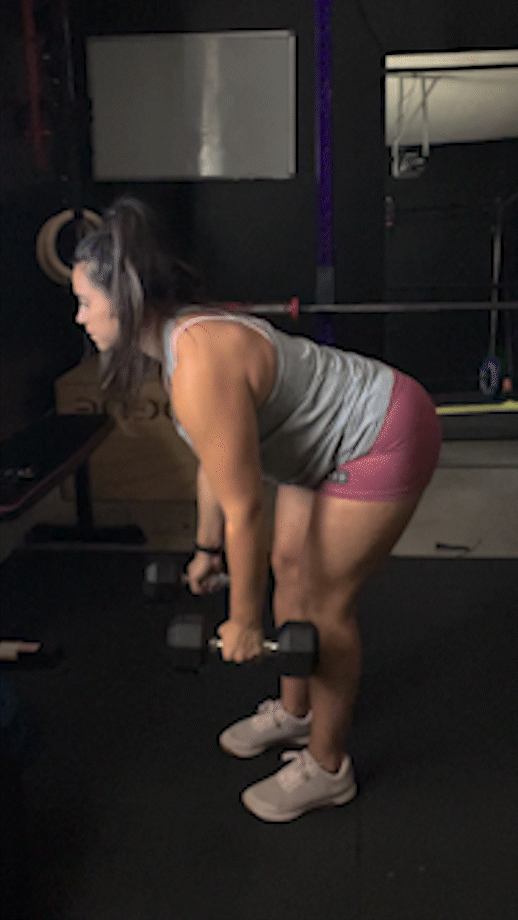
Shoulder Press
Muscles worked: Anterior, lateral, and posterior deltoid and triceps
Why you should do it: Trains all three shoulder muscles to improve the appearance and strength of your deltoids and triceps.
How to do it:
- Curl a pair of dumbbells to the front of your shoulders while seated or standing upright.
- Press overhead until your elbows are extended, and your biceps are by or behind your ears.
- Slowly lower down to the starting position and rest, and repeat.
Sets, reps, and rest time: Perform three sets of between six to 12 reps, resting two minutes between sets.
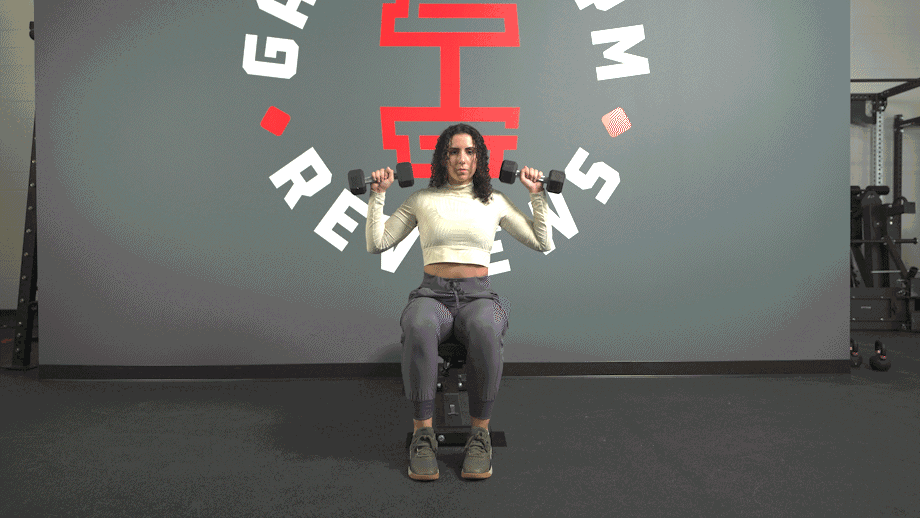
Lateral Raise
Muscles worked: Lateral deltoid
Why you should do it: It improves the size of your lateral delts to give your shoulders a wider appearance without the stress of performing shoulder presses.
How to do it:
- Hold a set of dumbbells by your side in a neutral grip, standing or seated. These should be light dumbbells.
- With your shoulders down and chest up, raise the dumbbells out to your side until they reach shoulder height.
- Slowly lower down and reset and repeat.
Sets, reps, and rest time: Perform two to three sets of 10 to 15 reps, resting one minute after each set.
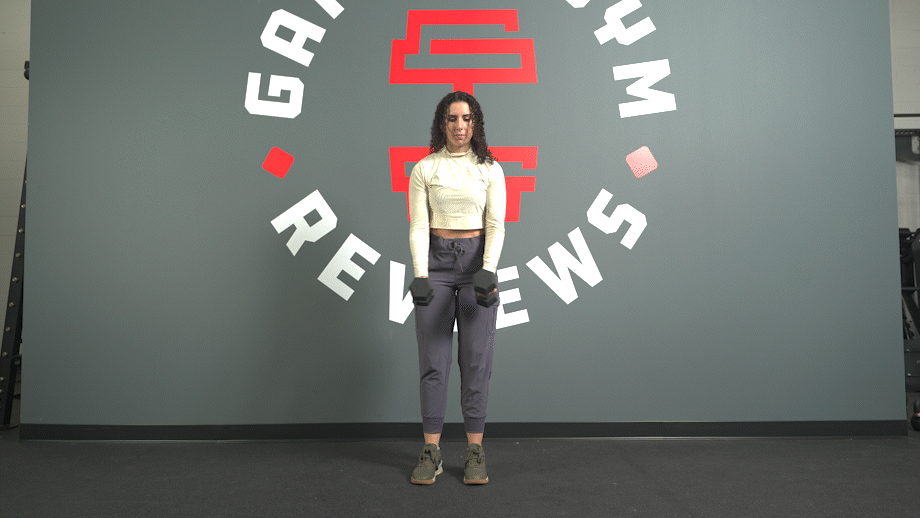
Turkish Get-up
Why you should do it: Usually performed with a kettlebell, the Turkish get-up can be done with a dumbbell. It works for all major muscle groups while getting up and down from the ground and increases your heart rate.
How to do it:
- While lying on the ground, put your right foot on the ground, slide your left leg out at 45 degrees, and do the same for the left arm.
- Raise your right arm with a dumbbell in your right hand directly above the shoulder.
- Push the right shoulder down and roll to your left side, raising your right hip and pushing your left elbow through the floor to get into the hip extension position.
- Straighten your left arm and sweep the left leg underneath until you’re half-kneeling position.
- Push your right foot through the floor to stand up with the dumbbell overhead.
- Slowly reverse the above steps to the starting position.
Sets, reps, and rest time: Perform three to five reps per side for three to four sets and resting two minutes after doing each side.
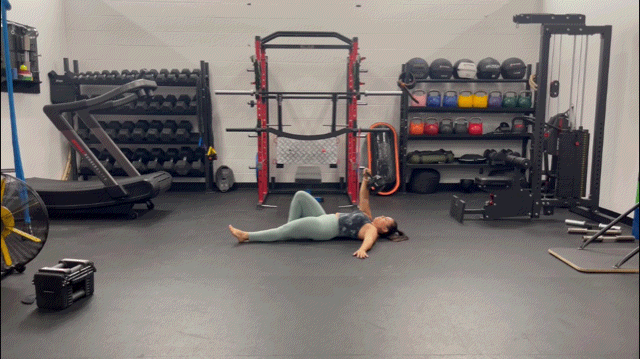
Muscles worked: Glutes, quads, traps, lower back, hamstrings, triceps, lats, and calves
Dumbbell Reverse Fly
Muscles worked: Hamstrings, glutes, lower back, and upper back
Why you should do it: Dumbbell reverse flys are a great weight training exercise to strengthen the entire posterior without using your biceps when performed in the hinge position.
How to do it:
- Have a pair of light dumbbells by your side and perform an RDL (described above) to get into the hinge position.
- With your shoulders down, chest up, and spine neutral, perform a reverse fly with a slight bend in your elbows.
- When you feel a muscle contraction between your shoulder blades, pause and lower to the starting position.
- Reset and repeat.
Sets, reps, and rest time: Perform two to three sets of 12 to 15 repetitions with a minute to 90 seconds rest between sets.
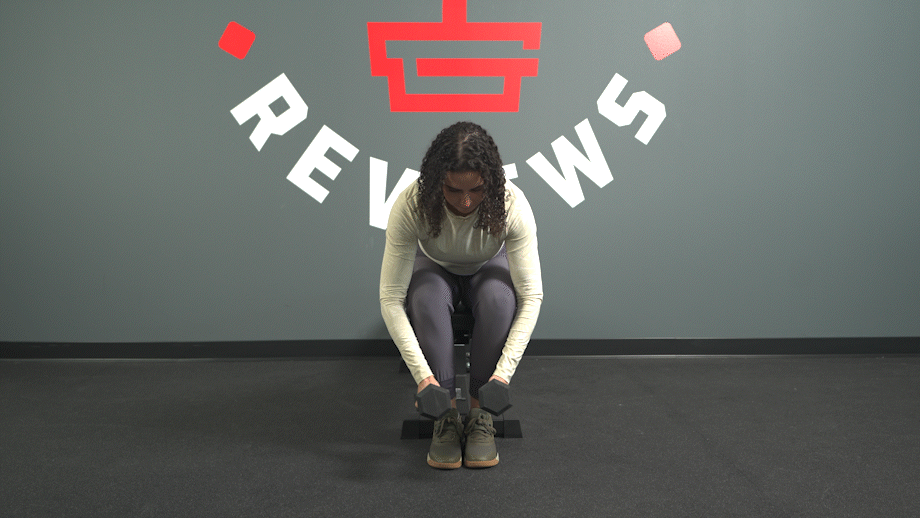
Dumbbell Split Squat
Muscles worked: Quads, glutes, and hamstrings
Why you should do it: Few people like split squats, but boy, as a leg extension alternative, they will strengthen your quads and glutes and balance while increasing muscle recruitment between sides for increased calorie burn.
How to do it:
- Hold a pair of dumbbells by your side, in the front rack position, or a single dumbbell in the goblet position.
- Lower into a half kneeling position, knee above ankle, ankle above the knee.
- Rise up and reset to get your balance.
- Drop your back knee towards the ground till it’s just above the floor.
- Push through your front foot to rise till lockout. That’s one rep.
Sets, reps, and rest time: Perform two to four sets of between six to 15 reps and rest one to two minutes after doing both sides.
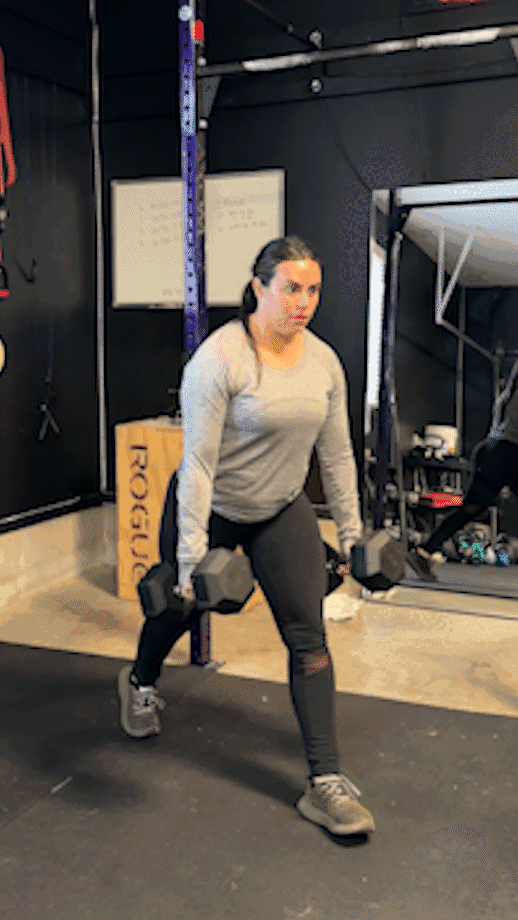
Dumbbell Hip Thrust
Muscles worked: Glutes and hamstrings.
Why you should do it: Just like the barbell variation but with a lighter weight, less stress on the lower back, and the ability to perform more reps for an excellent glute pump.
How to do it:
- Sit on the floor with a dumbbell on your hips and your back to a horizontal weight bench
- While holding the dumbbell with the side with both hands, get your upper back on the bench and perform a hip extension.
- Make sure your knees are at a 90-degree angle.
- Lower your hips to the ground and perform a hip extension, feeling it in your glutes and hamstrings. That’s one rep and reset and repeat.
Sets, reps, and rest time: Perform two to three sets of 12 to 20 reps with two minutes of rest between sets.
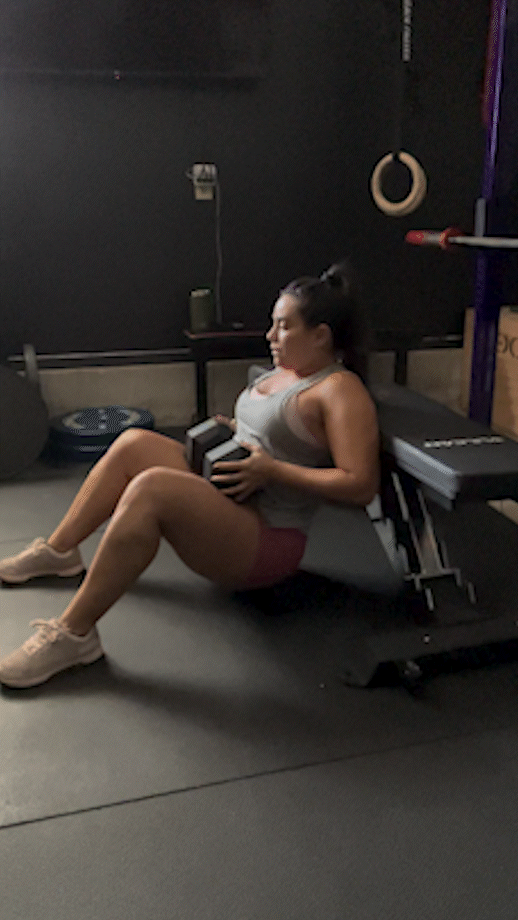
Dumbbell Squat-To-Press
Muscles worked: Hamstrings, glutes, quads, triceps, and shoulders
Why you should do it: Full-body combination exercise like the dumbbell squat to press train more lean muscle, burn more calories, and a great exercise when weight loss is your goal.
How to do it:
- Curl a pair of dumbbells to the front of your shoulders, with shoulders down and chest up.
- Get your feet hip-width apart or your preferred squat position.
- Squat down until your thighs are almost parallel to the floor.
- As you rise, start pressing the dumbbells overhead.
- Press until you’re standing up with the dumbbells overhead.
- Lower down to the starting position and reset and repeat.
Sets, reps, and rest time: Two to four sets of six to 12 reps with two minutes of rest between sets.
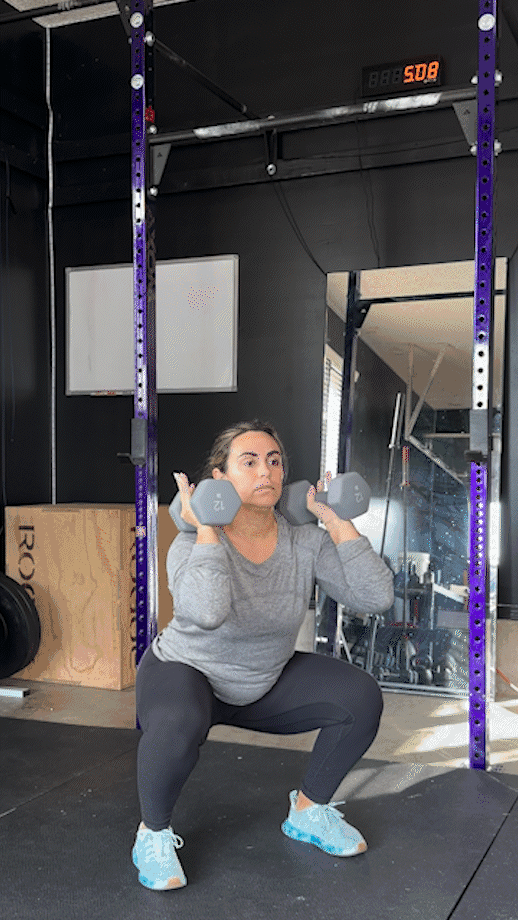
Dumbbell 3-Point Row
Muscles worked: Forearms, biceps, posterior deltoids, and upper back
Why you should do it: This single-arm row variation reduces your stability to make your core work harder while strengthening imbalances between sides.
How to do it:
- Stand facing a weight bench with a dumbbell by your feet.
- Push your hips back, put your left hand on the bench, and pick up the dumbbell with your right hand.
- Get your shoulders down, spine neutral, and row the dumbbell to the front of your right hip.
- Slowly lower until your arm is straight, and repeat for reps.
Sets, reps, and rest time: Perform two to four sets of between eight to 15 reps on each side, resting one to two minutes between sets.
RELATED: How to Barbell Row
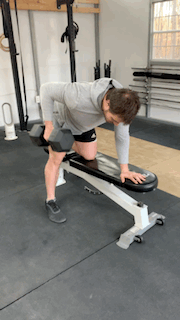
Dumbbell Pullover
Muscles worked: Lats, upper back, chest, triceps, and glutes.
Why you should do it: The pullover is a great exercise focusing on the lats and chest through an extensive range of motion for building muscle mass and more fat-loss potential.
How to do it:
- Set up as you would for the dumbbell hip thrust described above.
- Hold each end on the dumbbell and press it over your chest.
- Slowly lower it behind your head with a slight bend in your elbows.
- Pull the dumbbell back over your chest when you feel a stretch in your lats.
- Engage your glutes, reset, and repeat.
Sets, reps, and rest time: Perform two to three sets of between 10 to 15 reps, resting one to two minutes between sets.
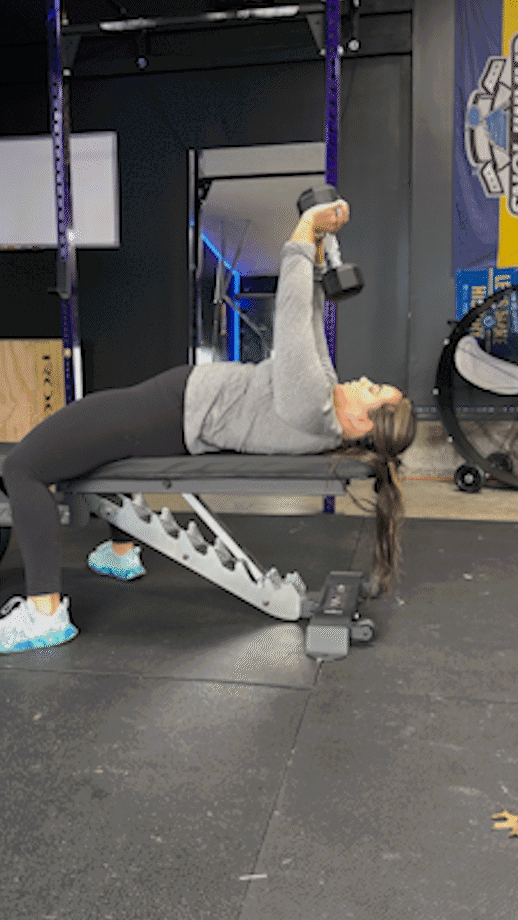
Benefits of Dumbbell Workouts for Weight Loss
Training with dumbbells can be less intimidating than the barbell for the beginner trainee, with strengthening muscle imbalances while being easier to use. Here below are several benefits of using dumbbells for weight loss.
Convenience
Dumbbells are cheaper to buy than barbells and weight plates, and you often don’t need a lot of space or other equipment when performing most dumbbell exercises; these facts make dumbbells easier to use.
Burns Calories
That’s what you are here for, right? Dumbbells increase the use of other muscles (besides the one being worked), which helps you breathe in more oxygen, increases the demands on your body, and helps you burn more calories.
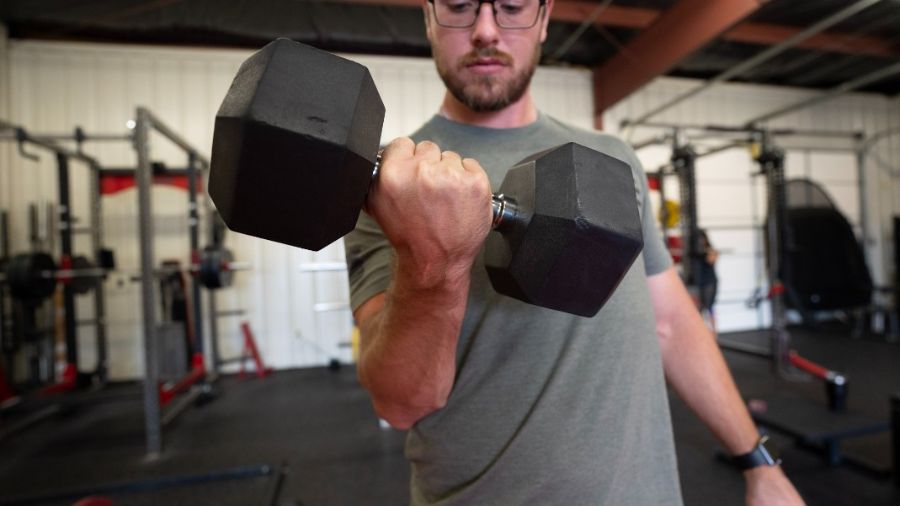
Improved Muscle Stabilization
You have more freedom of movement with dumbbells, and the range of motion is not often fixed like with gym machines and barbell exercises. These factors increase the demand for core and stabilizing muscles to help you burn more fat and get stronger.
Unilateral Training
You train unilaterally with a barbell and other gym tools. But dumbbells, with their ease of use, freedom of movement, and the ability to hold one or two dumbbells by your side, goblet, rack, or overhead make them more unilateral-friendly.
Build Muscle
Muscle is an active tissue; building muscle improves calorie burn and weight-loss potential. When you progressively overload your dumbbell workouts, eat enough protein, and recover well, you can build muscle with dumbbells.
Safety
Exercises where you are seated and the range of motion is fixed are among the safest for you to do. Dumbbell exercises may be safer than using the barbell, particularly in your home or garage gym, because you don’t need a spotter or other equipment. Their freedom of movement and ability to use a neutral grip makes it easier for your upper-body joints.
Dumbbell Workouts for Weight Loss: Final Thoughts
When it comes to weight loss, all gym equipment can work as long as you are in a calorie deficit and consistent with your workout routine. But dumbbells have an advantage over other tools due to their:
- Ease of use
- More core work
- Increased stabilization demands
- Decreasing strength imbalances between sides
When it comes to exercising for weight loss, you cannot beat dumbbells.
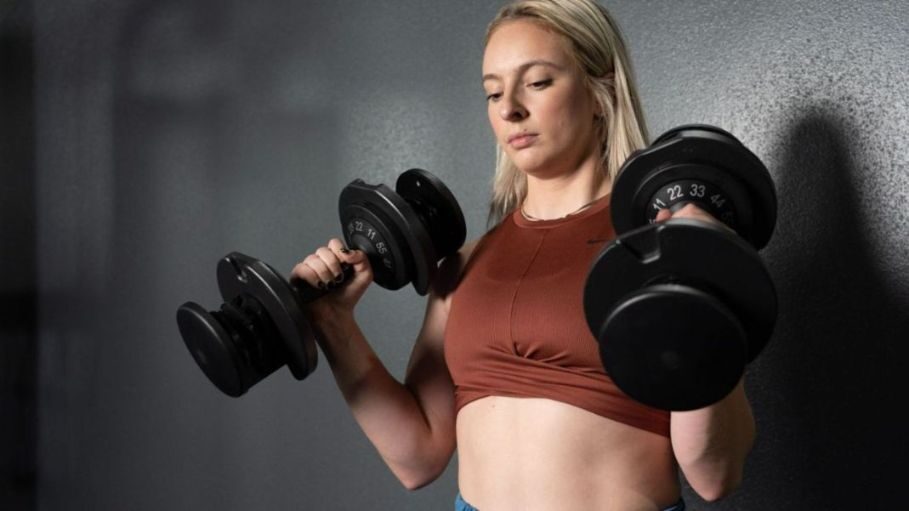
Dumbbell Workouts for Weight Loss: Q&A
Will dumbbells reduce belly fat?
Most gym equipment will reduce belly fat when you exercise consistently, in a calorie deficit, and meet your protein needs to build muscle. Dumbbells, with their ease of use, core training without crunches, and increased stability demands, are a more favorable tool than most for reducing body fat.
What dumbbell workouts burn fat?
Yes, dumbbell workouts will help you burn fat when you perform the exercises correctly and consistently. Make sure to perform full-body HIIT workouts like the one above because training more muscle will help you burn more fat
Can you lose weight using dumbbells?
You can lose weight using dumbbells, but only when you perform dumbbell exercises consistently, in a calorie deficit, and perform predominantly full-body workouts. Plus, it helps to throw in a little cardio in conjunction with using dumbbells.


